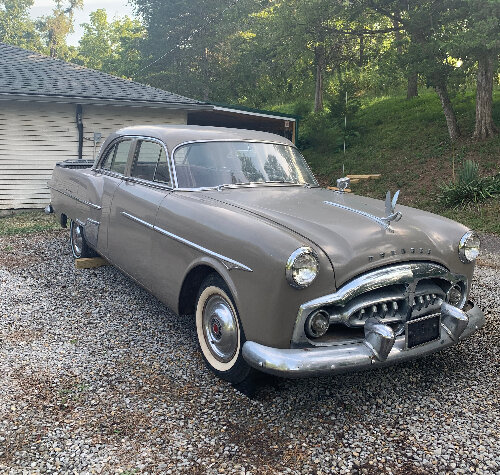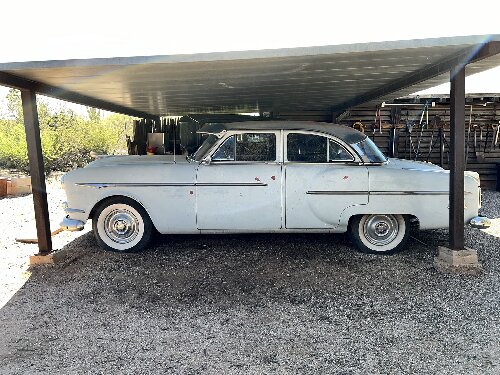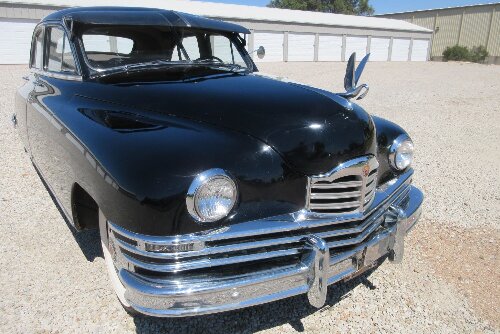|
Re: Twin Ultramatic Lifespan.
|
||||
|---|---|---|---|---|
|
Home away from home

|
Yes, I know first-hand, because in 1963, my parents traded in a mint condition 1956 Hudson Hornet because of two TU failures. I later saw it sitting on top of a pile in a local wrecking yard.
(To this day, I still consider those '55-'57 Hashes the ugliest US car of that era.) jack vines
Posted on: 2022/10/21 11:48
|
|||
|
||||
|
Re: Twin Ultramatic Lifespan.
|
||||
|---|---|---|---|---|
|
Home away from home

|
Quote:
Not many owners were willing to own a luxury car which couldn't be driven normally. jack vines
Posted on: 2022/10/20 11:52
|
|||
|
||||
|
Re: Oiling system history recap and update on the Oldsmobile oil pump conversion
|
||||
|---|---|---|---|---|
|
Home away from home

|
Update - the kits are back in stock and the backorders have all shipped.
jack vines
Posted on: 2022/9/19 11:34
|
|||
|
||||
|
Re: Yet another pump question
|
||||
|---|---|---|---|---|
|
Home away from home

|
A rod through the block is not a typical failure mode.
Run an extra pint of oil and hope for the best. jack vines
Posted on: 2022/8/29 23:05
|
|||
|
||||
|
Re: Packard shopping, what do you think of this car?
|
||||
|---|---|---|---|---|
|
Home away from home

|
Short answer from two thousand miles away - no; from your description, I wouldn't want that car as a gift.
Sixty years in the hobby has taught me to spend the money to pay an expert to evaluate a west-of-the-Rockies car and have it shipped east. Living out here, the cars are just so much less roached out than eastern cars. The other factor is late Packards haven't appreciated in value to the point one can't afford a better starting point. Opinions are worth what you paid for it, your money, your decision, your car to live with. jack vines
Posted on: 2022/8/29 11:07
|
|||
|
||||
|
Oiling system history recap and update on the Oldsmobile oil pump conversion
|
||||
|---|---|---|---|---|
|
Home away from home

|
The Packard V8 was only in production for less than a year and used in four different marques over two model years, 1955 and 1956. As with any new engine design, there were some problem areas with the Packard V8 which required redesign.
Chief among these is the oiling system. Early on, Packard Engineering began a series of improvements aimed at alleviating the valve lifter clicking at hot idle. They made three separate service changes to the oiling system: i. A service kit with a J-shaped copper tube to place in the outside of the pressure relief plunger bore and extend below the oil level in the pan. This didn’t solve the problem. ii. A running production change of a revised cam retainer plate and spacer to go from full pressure oiling of the cam chain to intermittent. This helped maintain higher pressure to the right front lifters, but wasn’t the solution. iii. A redesigned oil pump pressure relief system. These were late in the production life and are consequently very rare today. iv. A fourth modification, made by some of those servicing the Packard V8s was to eliminate the vacuum pump and replace it with a thick steel bottom plate. Again, an improvement, but not the solution. As we have learned with the benefit of years of observation, the design flaw in the oiling system was inherent and couldn’t be cured by band-aids. The oil pump used in the Packard versions of the engine is basically the same as that used by Cadillac, both with a vacuum pump piggybacked below it. The problem with the Packard application is to have clearance for the vacuum pump required the oil pump to be high in the pan, the top being above the oil level. Then, there’s the very long unsupported oil pump drive shaft used by Packard. Chrysler engineers designing an equally long drive system, placed a bronze bushing in a passage in the block to support the oil pump driveshaft. The Packard V8 does not have this bushing and as the miles and revolutions pass, the unrestrained forces wear the top of the drive shaft bore of the oil pump body. When the shaft bore becomes excessively worn and being above the oil level, the pump begins to suck air down the shaft and aerate the oil. It's time to note the oil pumps in the Packard V8s used in the 1955-56 Hudson and Nash and the 1956 Studebaker Golden Hawk did not have the vacuum pump, but still have the oiling problems inherent in the high placement of the oil pump and the long unsupported driveshaft. I have been able to come up with three solutions to the oiling problem: The first requires a complete redesign and rebuilding of the Packard oil pump. It begins with a 1955 Cadillac oil pump rebuild kit, including new gears and shafts. The Packard oil pump body driveshaft area is drilled larger and a cast iron bushing twice as long as the original bearing area is pressed in. A 3/8” thick bottom plate is machined with a bearing recess in it, so the oil pump driven shaft is supported top and bottom. This works well, but is too labor-intensive and thus too expensive for most to afford. The second also uses the new Cadillac gears and shafts in the Packard pump body, but without the bushing or the bottom plate. This has proven successful for the limited use most hobby cars get these days. It also has the benefit of being able to retain the vacuum pump for those Packard owners who want total originality. Still too much labor, but available for those who insist. The third, most common and least expensive, is to replace the Packard oil pump with a late Oldsmobile V8 oil pump and pickup. This concept was developed by three members here several years ago. One of the members tried producing the adapter kit via manual machining. This was too slow and too expensive and he was not able to do the final development necessary to perfect the kits. I was asked to take on the project and was incredibly fortunate to know a couple of talented machinists who would write a CNC program to produce the adapter kits. Without this happy coincidence, hundreds of Packard V8s would be dead in the water. The adapter kit consists of a very intricate doorstop-shaped steel adapter block, a steel driveshaft to mate the Packard distributor with the Oldsmobile oil pump and the bolts and printed instructions. Installation requires dropping the oil pan, removing the OEM pump, plugging the vacuum line hole in the side of the block on the Packard versions, installing the new parts and refitting the pan with a new pan gasket. The combination of a new oil pump placed lower in the oil has been the solution for most of the Packard V8 oiling problems. There is also a high volume version of the Oldsmobile oil pump and pickup. The only time I recommend using the high volume unit is on an engine with enough wear in the main bearings to show low oil pressure. The 2022 costs for these are: Oil pump conversion kit - $250 Oldsmobile oil pump and pickup - $150 High volume Olds pump and pickup - $250 Shipping - $10 to $20 depending on which is ordered. We’ve sold hundreds of these kits and they’ve been shipped all over the world. Who knew there were Packard V8s in Tasmania, India, Australia, New Zealand, Sweden, Norway, Germany, France, et al ? If anyone reading this thinks he might ever need one of these kits, I suggest he order one now, as they are being made as a favor to me; neither I nor the favor are guaranteed to last indefinitely. Personal check is OK. Studebaker-Packard V8 Limited Jack Vines 3227 E 28th Ave Spokane, WA 99223 (509) 953-6023
Posted on: 2022/8/27 13:10
|
|||
|
||||
|
Re: 2 1956 Packard 400 Coupes
|
||||
|---|---|---|---|---|
|
Home away from home

|
Someone got both an incredible bargain on two very rare '56s and also a bottomless money pit; two for the price of one, indeed!
jack vines
Posted on: 2022/7/20 10:36
|
|||
|
||||
|
Re: Someone hooked the battery up backwards / new member 55 Clipper Deluxe
|
||||
|---|---|---|---|---|
|
Home away from home

|
Quote:
The Packard V8 heads are heavier than the hubs of hell, around 60# loaded. When I was younger, I could lift one out over the fender with the hood on. Age and experience has taught that's not a good idea. I wouldn't even try to pull the heads with the engine in place. What's the goal? If the engine is stuck, it's likely to require a complete disassembly any way. However, if you're stubborn, try a cherry picker engine hoist. Use a short length of chain between the two outer exhaust manifold bolts. Take a light strain, bang with a 5# rawhide hammer or similar deadblow plastic hammer. jack vines
Posted on: 2022/5/17 11:20
|
|||
|
||||
|
Re: Packard V8 exhaust valves
|
||||
|---|---|---|---|---|
|
Home away from home

|
Quote:
BTW, when the new parts were NLA, we've machined 352" and 374" pistons from Ford and Chevy parts, machined the connecting rod small end to fit the Ford and Chevy piston pins, recut head spring pockets for valve springs, machined down exhaust valves, et al. jack vines
Posted on: 2022/5/6 9:07
|
|||
|
||||








